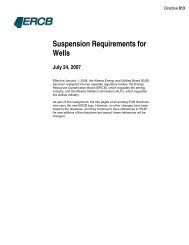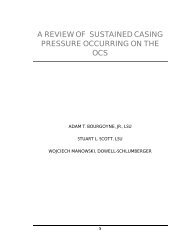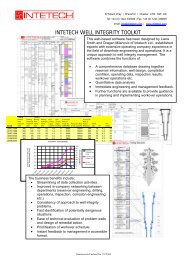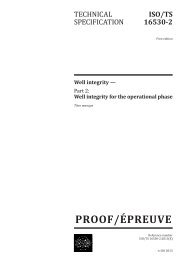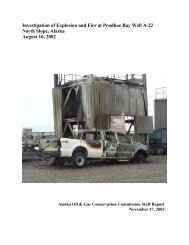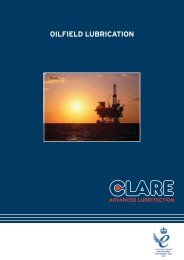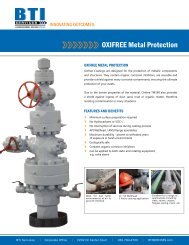Report Investigation of gas blowout on Snorre A - Well Integrity ...
Report Investigation of gas blowout on Snorre A - Well Integrity ...
Report Investigation of gas blowout on Snorre A - Well Integrity ...
Create successful ePaper yourself
Turn your PDF publications into a flip-book with our unique Google optimized e-Paper software.
to provide for barrier integrity as well as well c<strong>on</strong>trol. (Ref. the Facilities Regulati<strong>on</strong>s,<br />
Secti<strong>on</strong> 83, No. 2 relating to entry into force.)<br />
• The Activity Regulati<strong>on</strong>s, Secti<strong>on</strong> 27 relating to Planning, which require that the<br />
planning shall take into account the status <str<strong>on</strong>g>of</str<strong>on</strong>g> important c<strong>on</strong>tributors to risk and to the<br />
change in risk.<br />
• Odfjell Drilling's ”Golden Rules”<br />
5.1.24 N<strong>on</strong>-c<strong>on</strong>formity 24. Inadequate well barriers when pulling scab-liner through<br />
BOP<br />
On 28 November 2004, just after 0500 hours, the scab-liner was pulled through the BOP.<br />
When a 7 5/8” scab-liner is pulled through the <str<strong>on</strong>g>blowout</str<strong>on</strong>g> preventer, the functi<strong>on</strong> <str<strong>on</strong>g>of</str<strong>on</strong>g> the upper<br />
and lower pipe ram are primarily affected, while a sec<strong>on</strong>dary effect is in relati<strong>on</strong> to the<br />
functi<strong>on</strong> <str<strong>on</strong>g>of</str<strong>on</strong>g> the shear ram. There is no possibility <str<strong>on</strong>g>of</str<strong>on</strong>g> cutting or holding the scab-liner.<br />
Evidence:<br />
It emerged from interviews that the scab-liner was pulled through the BOP without Statoil<br />
ensuring that the risk was evaluated and compensatory measures were established.<br />
Requirement:<br />
• The Activity Regulati<strong>on</strong>s, Secti<strong>on</strong> 76 relating to <strong>Well</strong> barriers requires that, during<br />
drilling and well activities, there shall at all times be at least two independent and<br />
tested well barriers after the surface casing is in place.<br />
5.1.25 N<strong>on</strong>-c<strong>on</strong>formity 25. Inadequate risk assessments in c<strong>on</strong>necti<strong>on</strong> with swabbing<br />
On 27 November 2004 at night, during pulling <str<strong>on</strong>g>of</str<strong>on</strong>g> the scab-liner, the crew observed swabbing<br />
for the first time. Several known factors could lead to and reinforce swabbing, which is<br />
regarded as being an important c<strong>on</strong>tributing factor for risk. Am<strong>on</strong>g other things, swabbing<br />
could occur as a c<strong>on</strong>sequence <str<strong>on</strong>g>of</str<strong>on</strong>g> minimal clearance between the scab-liner and 9 5/8” casing,<br />
and as a c<strong>on</strong>sequence <str<strong>on</strong>g>of</str<strong>on</strong>g> ”gelling”.<br />
In the event <str<strong>on</strong>g>of</str<strong>on</strong>g> communicati<strong>on</strong> with hydrocarb<strong>on</strong>-bearing z<strong>on</strong>es, swabbing will lead to <str<strong>on</strong>g>gas</str<strong>on</strong>g><br />
and other formati<strong>on</strong> liquids being sucked into the well. The mixture <str<strong>on</strong>g>of</str<strong>on</strong>g> <str<strong>on</strong>g>gas</str<strong>on</strong>g> and drilling mud<br />
reduces the specific gravity <str<strong>on</strong>g>of</str<strong>on</strong>g> the drilling fluid and the barrier functi<strong>on</strong> <str<strong>on</strong>g>of</str<strong>on</strong>g> the mud is affected.<br />
Failure <str<strong>on</strong>g>of</str<strong>on</strong>g> the primary barrier (the drilling mud) after swabbing is <strong>on</strong>e <str<strong>on</strong>g>of</str<strong>on</strong>g> the causes that<br />
triggers the incident <strong>on</strong> P-31A. The crew were unable to restore the primary barrier after<br />
swabbing.<br />
Evidence:<br />
In interviews and <strong>on</strong> the daily drilling report, it emerges that the drilling management was<br />
uncertain <str<strong>on</strong>g>of</str<strong>on</strong>g> the status <str<strong>on</strong>g>of</str<strong>on</strong>g> the primary barrier. They implemented counter-measures<br />
(flowchecks) that proved to be insufficient.<br />
Other activities were c<strong>on</strong>ducted in the well, other than those aimed at restoring barriers.<br />
The drilling management was aware <str<strong>on</strong>g>of</str<strong>on</strong>g> the effect <str<strong>on</strong>g>of</str<strong>on</strong>g> ”gelling” from previous incidents 34 . The<br />
detailed plans showed that previous incidents were not taken into c<strong>on</strong>siderati<strong>on</strong>, and swabbing<br />
was not listed as a risk factor.<br />
Requirement:<br />
34 Ref. Incident <strong>on</strong> well P-02 in September 2003.<br />
35



